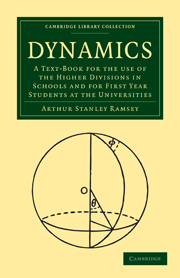 Dynamics
Dynamics Book contents
- Frontmatter
- PREFACE
- Contents
- Chapter I INTRODUCTION
- Chapter II VECTORS
- Chapter III RECTILINEAR MOTION. KINEMATICS
- Chapter IV RECTILINEAR MOTION. KINETICS
- Chapter V KINEMATICS IN TWO DIMENSIONS
- Chapter VI DYNAMICAL PROBLEMS IN TWO DIMENSIONS
- Chapter VII HARMONIC MOTION
- Chapter VIII MOTION UNDER CONSTRAINT
- Chapter IX THE LAW OF REACTION. GENERAL PRINCIPLES
- Chapter X GENERAL PROBLEMS
- Chapter XI IMPULSIVE MOTION
- Chapter XII POLAR COORDINATES. ORBITS
- Chapter XIII MOMENTS OF INERTIA
- Chapter XIV MOTION OF A RIGID BODY. ENERGY AND MOMENTUM
- Chapter XV EQUATIONS OF MOTION OF A RIGID BODY
- Chapter XVI MISCELLANEOUS PROBLEMS
- Chapter XVII SMALL OSCILLATIONS
Chapter XVI - MISCELLANEOUS PROBLEMS
Published online by Cambridge University Press: 07 September 2010
- Frontmatter
- PREFACE
- Contents
- Chapter I INTRODUCTION
- Chapter II VECTORS
- Chapter III RECTILINEAR MOTION. KINEMATICS
- Chapter IV RECTILINEAR MOTION. KINETICS
- Chapter V KINEMATICS IN TWO DIMENSIONS
- Chapter VI DYNAMICAL PROBLEMS IN TWO DIMENSIONS
- Chapter VII HARMONIC MOTION
- Chapter VIII MOTION UNDER CONSTRAINT
- Chapter IX THE LAW OF REACTION. GENERAL PRINCIPLES
- Chapter X GENERAL PROBLEMS
- Chapter XI IMPULSIVE MOTION
- Chapter XII POLAR COORDINATES. ORBITS
- Chapter XIII MOMENTS OF INERTIA
- Chapter XIV MOTION OF A RIGID BODY. ENERGY AND MOMENTUM
- Chapter XV EQUATIONS OF MOTION OF A RIGID BODY
- Chapter XVI MISCELLANEOUS PROBLEMS
- Chapter XVII SMALL OSCILLATIONS
Summary
16.·1. Rolling and Sliding. When sliding takes place the friction F bears a constant ratio μ to the normal reaction R but when rolling takes place the friction has generally a much smaller value.
When two bodies in contact at a point A have a relative motion the process of determining whether this motion involves rolling or sliding at A is as follows:
Write down the equations of motion which involve the friction F and the normal reaction R, and assuming
(i) that rolling takes place also write down the kinematical condition which expresses the fact that there is no relative tangential velocity at A. If from the solution of these equations we find that F/R is less than the coefficient of friction μ, the assumption that rolling takes place is justified and rolling will continue until F/R becomes greater than μ.
(ii) Assuming that sliding takes place, write μR instead of F in the equations of motion and solve the equations without the kinematical condition above referred to. If the solution shews that there is a relative tangential velocity at A and the direction of motion is opposed to what has been assumed as the direction of the friction then we have found the true motion and it will continue until relative velocity at A vanishes.
16·2. A wheel spinning about a horizontal axis is projected along a rough horizontal plane, to determine the subsequent motion.
Let m be the mass and a the radius of the wheel, mκ2 its moment of inertia about its centre G, and A the point of contact with the plane.
- Type
- Chapter
- Information
- DynamicsA Text-Book for the Use of the Higher Divisions in Schools and for First Year Students at the Universities, pp. 231 - 246Publisher: Cambridge University PressPrint publication year: 2009First published in: 1929
